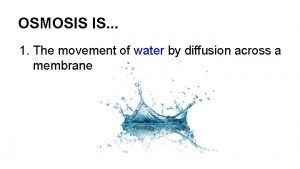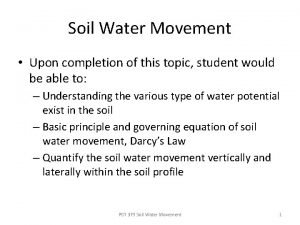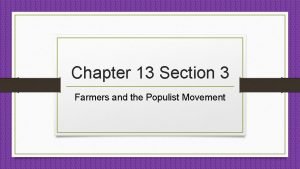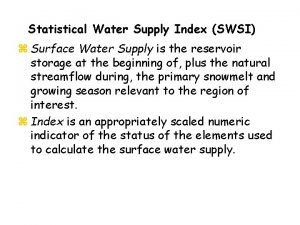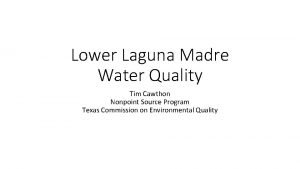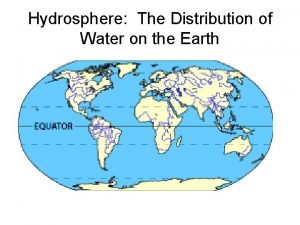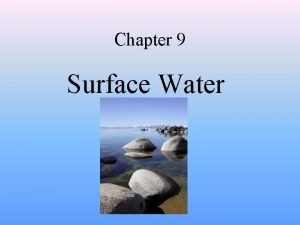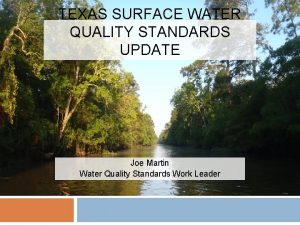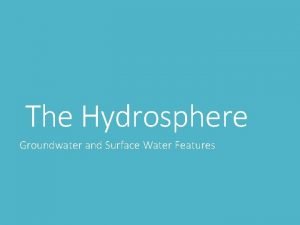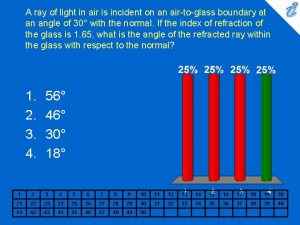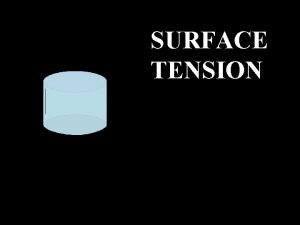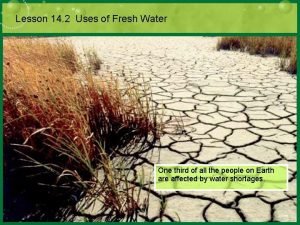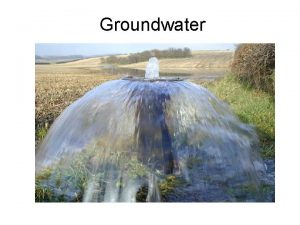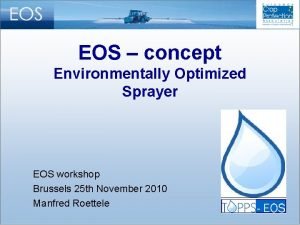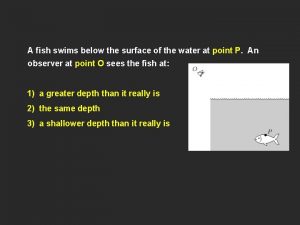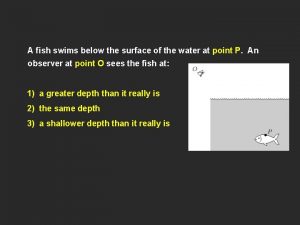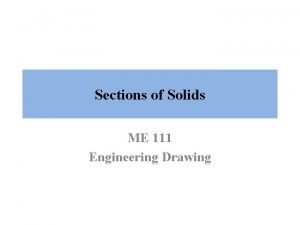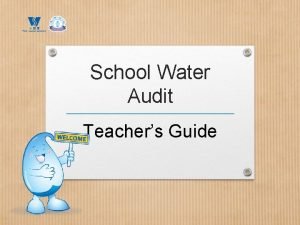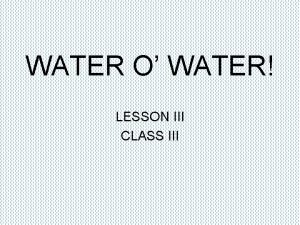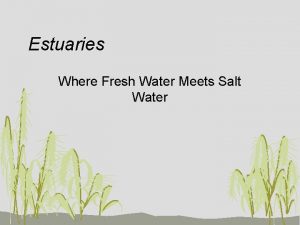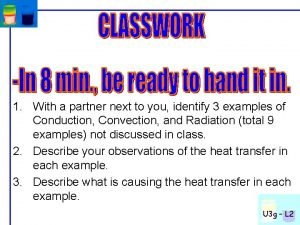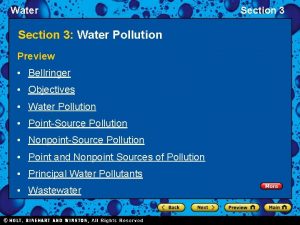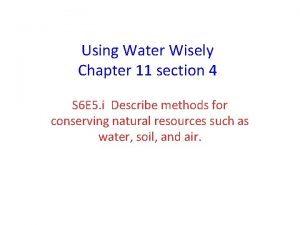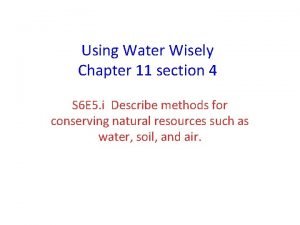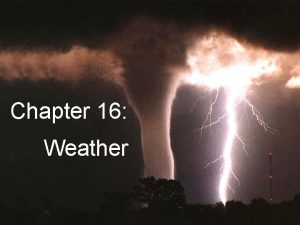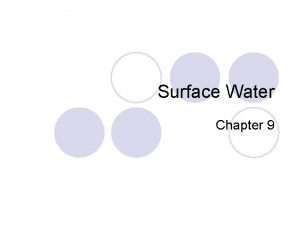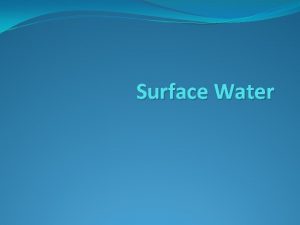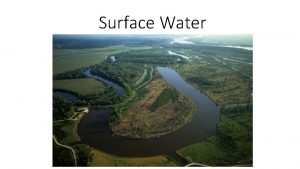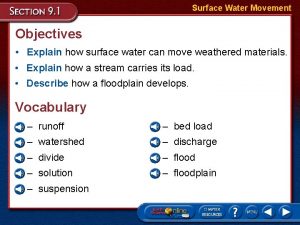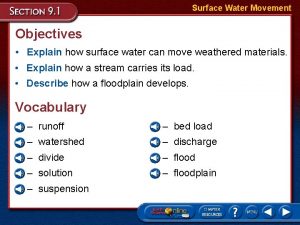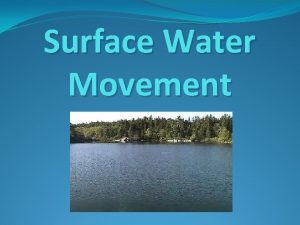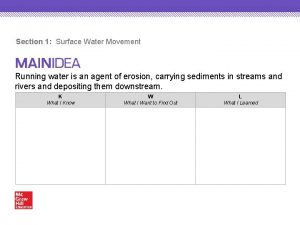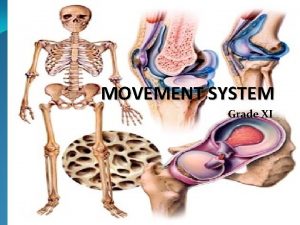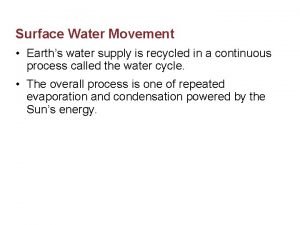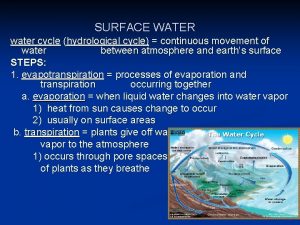Surface Water Section 1 Surface Water Movement Section













































- Slides: 45

Surface Water Section 1: Surface Water Movement Section 2: Stream Development Section 3: Lakes and Freshwater Wetlands

• Section 1: Running water is an agent of erosion, carrying sediments in streams and rivers and depositing them downstream. • Section 2: Streams erode paths through sediment and rock, forming V-shaped stream valleys. • Section 3: As the amount of water changes and the amount of sediments increases, lakes can be transformed into wetlands and eventually into dry land.

Section 1 – Surface Water Movement • Essential Questions: – How can surface water move weathered materials? – How does a stream carry its load? – How does a floodplain develop?

The Water Cycle • Earth’s water supply is recycled in a continuous process called the water cycle. • Water evaporates from a body of water or the surface of Earth, condenses into cloud droplets, falls as precipitation back to Earth and the water cycle repeats. • Often water involves time spent within a living organism or as part of a snowfield, glacier, lake, or ocean.


Runoff • Water flowing downslope along Earth’s surface is called runoff. • The runoff may reach a body of water or form a puddle and evaporate. • Water that infiltrates into Earth’s surface becomes groundwater. • For water to enter the ground a certain number of conditions must exist.

• There must be large enough pores in the ground for the water to enter. • If the pores are filled the water will stand on the ground in puddles. • Soil composition is the physical and chemical composition of the soil. • Soil that consists of decayed organic matter – humus – creates pores in the soil.

• The size of the particles – sand, silt, or clay – has different size pores. • Sand has a lot of spaces and allows a lot of water to pass through quickly. • Clay has very small spaces and water has a hard time getting in. • Humus has “just the right amount” or pores and allows the water in and holds it in.

• Rate of precipitation affects the amount of water that runs off. • Light, gentle precipitation can infiltrate the ground. • Heavy rain quickly fills the pores and then becomes runoff. • A gentle, long-lasting rainfall is more beneficial to plants and causes less erosion.

• Soils that contain grasses or other vegetation allow more water to enter the ground than do soils with no vegetation. • The roots help maintain pore spaces. • Soil with no vegetation becomes more compacts with the rain and then allows more runoff.

• The steepness of the ground affects water infiltration. • Steep slopes have faster runoff and have a greater potential for erosion.

• Water that does not enter the ground eventually collects in streams. • As the rain falls it will collect on the surface to form puddles. • The puddles will combine to form bigger puddles. • The bigger puddles will eventually collect in stream channels forming streams.

• As the runoff increases the stream channel widens. • Streams flow downhill and will collect in larger rivers, lakes, or oceans • Rivers that flow into other streams are called tributaries.

• All the land area whose water drains into a stream system is called the system’s watershed. • A divide is an elevated land area that separates one watershed from another.


Stream Load • The material that a stream carries is known as stream load. Stream load is carried in three ways. • Materials in suspension – small particles are held up by the turbulence of the moving water. Faster moving can have more and larger particles in suspension.

• Bed load are sediments that are too large to be held up by the turbulence of the water. • A stream’s bedload consists of sand, pebbles, and cobbles that the can roll or push along the bottom. • The faster the stream moves the larger the particles it can move. • As the particles move they rub against each other or the streambed.

• Minerals that are dissolved in the stream’s water are called materials in solution. • When water runs over rocks small amounts of minerals are dissolved and carried in the water. • The amount of dissolved material is measured on parts per million (ppm)

• The stream’s ability to transport material – carrying capacity – depends on both the velocity and the amount of water. • The discharge is the amount of water that flows past a given point over a period of time. • The capacity depends on the channels slope, depth, and width.


• The discharge of a stream is calculated as follows: • Discharge = average width X average depth X average velocity • (m³/s) (m) (m/s)

• The largest river in the U. S. – the Mississippi River – has a huge discharge of about • 17, 000 m³/s • The Amazon River, the largest in the world, has a discharge of about 170, 000 m³/s. • As a stream’s discharge increases, its carrying capacity also increases.

• The velocity of a river is fastest in the center of the river over the deepest part. • It will slow down as it gets deeper and closer to the edges because of friction. • As a river turns the water will move fastest around the outer part of the turn. • Flowing streams reshape the landscape.


Floods • Sometimes more water enters a stream than the banks of the stream can hold. • A flood occurs when water spills over the sides of a stream’s banks onto adjacent land. • The broad area that extends out from a stream’s bank and is covered by excess water during times of flooding is known as the stream’s floodplain.

• Since rapidly moving water carries large amount of sediments, when flooding occurs the water will drop fertile sediments on the floodplain.


Section 2 – Stream Development • Essential Questions: – What physical features are characteristic of stream development? – What is the relationship between meanders and stream flow? – How is the process of rejuvenation in stream development explained?

Supply of Water • Stream formation relies on an adequate water supply. • As a stream develops, it changes width and size, and shapes the land over which it flows. • Stream channels is a narrow pathway that the water carves into the sediment or rock. • The channel widens and deepens as more water accumulates and cuts into the Earth’s surface.

• The movement of water is the force of gravity. • When the gradient is steep, the water moves rapidly. • Meanders are bends or curves in a stream caused by moving water. • Water in straight paths move at maximum velocity. • Water along the bottom and sides move more slowly because of friction.

• Water moves the fastest around the outside of a meander. • There is more erosion along the outside because of the fastest moving water. • Along the inside edge since the water is moving the slowest the sediments are deposited.

• Over time the meander gets larger and turns into an oxbow lake as the water supply is cutoff and the stream begins to flow straight again. • The part of the river that leads into a larger body of water is called the mouth.

Deposition of Sediments • All streams are able to carry sediments but when they lose their velocity the sediments begins to deposit. • Alluvial fans are deposition features at the end of rivers in dry regions. • The streams place the deposits in a fanshaped deposit.

• When a stream enters a large deposit of water they form a triangular deposit called a delta. • Deltas usually consist of silt and clay particles.

Alluvial Fan

Delta

Section 3 – Lakes and Freshwater Wetlands • Essential Questions: – How do freshwater lakes and wetlands form? – How is the process of eutrophication described? – What are the effects of human activity on lake development?

Lakes • Lakes are bodies of water surrounded by land. • Oxbow lakes form from the cutoff of meanders. • Lakes can form when a river is cutoff by a landslide. • Some lakes are formed by glaciers.

• Water from precipitation, runoff, and underground sources can maintain a lake’s water supply. • Some lakes may only contain water after heavy rains or after spring thaws. • Lakes are only temporary. • After hundreds of thousands of years the lakes fill in with sediments.

Eutrophication • The process by which the surrounding watershed enriches bodies of water with nutrients that stimulate excessive plant growth. • Plants in the water add oxygen to the water. • Animals that live in the water need oxygen. • When too much nitrogen and phosphorus is added to the water algae thrives.

• The algae will bloom on top of the water and block the sunlight from reaching the bottom of the lake. • These sunlight dependent plants die. • When the plants die there is less oxygen in the water. • More dead organisms depletes more oxygen. • The algae can also release toxins into the water.


• A wetland is any land area that is covered with water for a part of the year. • Wetlands include bogs, marshes, and swamps. • Bogs receive water from precipitation only. • Marshes form along the mouths of streams with deltas. • The marshes are rich in grasses that further slows the water and deposit more sediments.

• Abundant wildlife is common in marsh areas. • Swamps are low-lying areas located near streams. • Swamps develop from marshes that have filled with shrubs and trees. • Swamps that formed 300 million years ago (mya) developed into our current coal reserves.

• Wetlands improve the water quality. • They act as a filtering system. • They act as a habitat for waterbirds and other life. • Preservation of the wetlands has become a global concern.
 Water and water and water water
Water and water and water water Movement vs non movement area
Movement vs non movement area What is locomotor dance
What is locomotor dance How does water move through plants
How does water move through plants Water movement in xylem
Water movement in xylem Osmosis
Osmosis Water movement
Water movement Chapter 13 section 3 farmers and the populist movement
Chapter 13 section 3 farmers and the populist movement Farmers and the populist movement section 3
Farmers and the populist movement section 3 Chapter 13 section 3 farmers and the populist movement
Chapter 13 section 3 farmers and the populist movement How to find lateral area of a rectangular prism
How to find lateral area of a rectangular prism Spin coat
Spin coat Wet curved surface area
Wet curved surface area Surface water supply index
Surface water supply index Njdep groundwater quality standards
Njdep groundwater quality standards Tceq
Tceq Water covers earth surface
Water covers earth surface Water flowing downslope along earth's surface
Water flowing downslope along earth's surface Texas surface water quality standards
Texas surface water quality standards Chapter 9 surface water chapter assessment answer key
Chapter 9 surface water chapter assessment answer key Surface water features
Surface water features How does water purity affect surface tension hypothesis
How does water purity affect surface tension hypothesis A ray of light in air is incident
A ray of light in air is incident How much of the earth's surface is covered with water
How much of the earth's surface is covered with water Surface tension meaning
Surface tension meaning Uses of surface water
Uses of surface water Uses of groundwater
Uses of groundwater Eos workshop
Eos workshop A fish swims below the surface of the water
A fish swims below the surface of the water A fish swims below the surface of the water
A fish swims below the surface of the water True shape of section
True shape of section Drinking fountain
Drinking fountain Fwa in ship
Fwa in ship Water o water
Water o water 5 divided by 1/4
5 divided by 1/4 Class 8 english chapter 7 water water everywhere
Class 8 english chapter 7 water water everywhere Water heat exchanger
Water heat exchanger Fresh water meets salt water
Fresh water meets salt water Warm water rises in a lake. cold water descends.
Warm water rises in a lake. cold water descends. Clil water
Clil water Explain important of watershed management
Explain important of watershed management Unit 11 water water everywhere
Unit 11 water water everywhere Section 3 water pollution
Section 3 water pollution Chapter 11 section 4 using water wisely answer key
Chapter 11 section 4 using water wisely answer key We think we are using water wisely because
We think we are using water wisely because Chapter 16 section 1 water in the air answer key
Chapter 16 section 1 water in the air answer key





